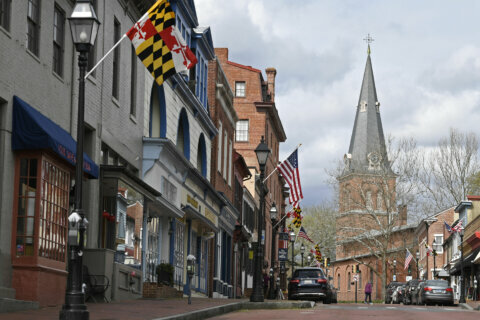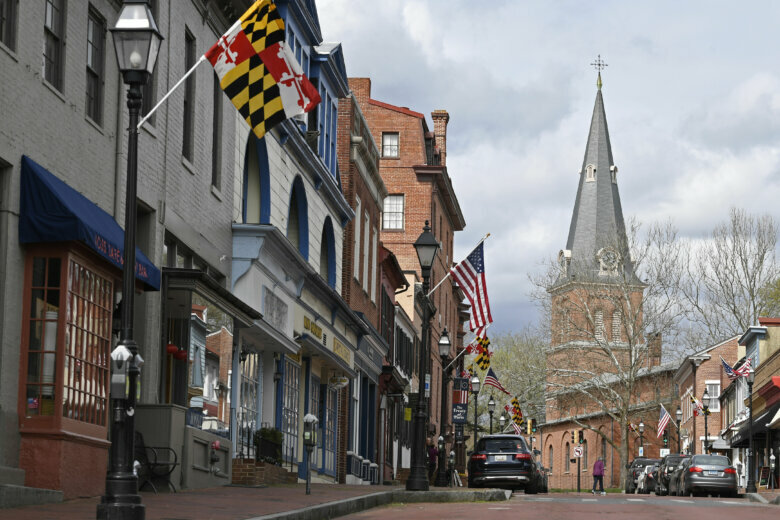

The latest
- D.C. Mayor Muriel Bowser and Maryland Gov. Larry Hogan were both on national TV Sunday morning discussing racial disparities in COVID-19 cases and the prospect of economic life returning to normal.
- The Virginia Department of Health on Sunday reported 197 new cases of COVID-19 and 11 more deaths, bringing the commonwealth’s totals to 5,274 and 141 respectively.
- Maryland on Sunday reported another 531 cases, bringing the total to 8,225, and 29 more deaths for a total of 235 lives lost.
- D.C. has reported a total of 1,875 cases of COVID-19, an increase of 97 overnight, and three more deaths, bringing the total to 50.
- D.C. is closing a few roads to help people get out and get some exercise while practicing safe social distancing.
- If you haven’t filed tax returns for the past two years, the IRS has a new way for you to get the federal government’s Economic Impact Payments.
The symptoms of COVID-19 are fever, coughing and shortness of breath. Health officials say that if you have these symptoms, you should call your doctor. Don’t just show up. Medical facilities need to get ready for you. If you don’t have a doctor and you live in D.C. or the nearby Maryland suburbs, D.C.’s mayor recommends calling the Testing Triage Center at 855-363-0333 or Mary’s Center at 844-796-2797. If you live in Virginia, call 211.
Hogan, Bowser on national TV
Hogan: ZIP code data on COVID-19 patients available
On ABC’s This Week, Maryland Gov. Larry Hogan said data on cases of COVID-19 in the state would be broken down by ZIP code in an effort to speed help to areas which need the most help in fighting infection.
The information is now available on the Maryland coronavirus website, and offers the most localized breakdown of positive cases in the region thus far.
He spoke as more data confirmed the disparate impact of the pandemic on black and Hispanic communities.
“This disparity among African-Americans is very disturbing,” Hogan said. It had been hard to track because the CDC and federal laboratories weren’t tracking results on race. He said Maryland now has racial data on about 80% of cases.
He said his administration would use the ZIP code data to focus resources. “Almost all of our focus” has been on the corridor between Baltimore and D.C., including Prince George’s County and Montgomery County, Hogan said, adding that he’s told the federal government that the area is an emerging hotspot.
The governor was asked to react to President Donald Trump’s statement Friday that “We’re in great shape … we’re getting very few calls from governors or anyone else needing anything.”
Hogan, the chairman of the National Governors Association, responded that he had held 12 calls with the nation’s governors, eight of which Trump or Vice President Mike Pence sat in on. While “We’ve certainly seen an improvement over the past week from the week before” and “everyone has gotten more supplies,” Hogan said, Trump’s assertion is “not quite accurate. Everyone still has tremendous needs on personal protective equipment.”
Gov. Hogan was asked about Trump’s desire to have restrictions such as stay-at-home orders and business closings lifted by May 1, and responded, “We haven’t got any kind of an artificial deadline on that.”
He said the state, which has seen an unprecedented uptick in unemployment insurance filings, is facing an “incredible economic challenge,” agreed that restoring life to normal was important, “”but right now the first thing is saving lives and keeping people safe. … “You can’t just pick a date and flip a switch. I don’t think it’s going to be that simple.”
Bowser: Virus shines ‘spotlight’ on inequality
On Fox News Sunday, D.C. Mayor Muriel Bowser said that the District was preparing for a surge in cases that could peak as late as June. Asked about the difference between that projection and predictions from neighboring states, Bowser said that “All of the interventions that we put in place in the early part of March … [have] pushed out when the peak might occur.”
Host Chris Wallace pointed out that the virus has taken an economic tool on the District as well: Almost 60,000 residents have filed for unemployment claims since March 13, more than double the number who filed in all of last year.
Bowser replied that “It was our hospitality and tourism sector that was struck first,” and hoped to be able to return life to normal as soon as possible, but added, “We’re looking to national experts and the CDC to tell us when things can slowly turn back on so we can get people back to work.”
Reminded of Trump’s optimistic notion of dropping safety guidelines May 1, Bowser pointed out that “the most optimistic models,” including those the White House task force has pointed to, are based on guidelines staying in place until the end of May. For her part, she said, “What we’re looking for [before removing safety orders] is sustained periods of decreasing infection, sustained periods of decreasing hospitalizations.”
Bowser pointed out that Trump can’t lift any stay-at-home orders because he hasn’t issued any, so “We’re going to look at our experience in Washington, D.C. .. We know we can’t just flip a switch … we could suffer a rebound and lose all the gains we’ve made.”
Wallace pointed to a CDC finding that 33% of hospitalized COVID-19 patients in a study were African American, even though they only made up 18% of the population in the areas studied.
Bowser repeated a point she had made Thursday, saying the virus had placed “a spotlight on the health disparities that have plagued African-Americans for generations.
“And you can trace [it to] slavery, racism, Jim Crow … you can also look to how many African-Americans are living in substandard housing conditions,” which contribute to all sorts of the kind of underlying health problems that lead to deaths among COVID-19 patients, the mayor said.
By the numbers
All nine coronavirus-related deaths reported by the D.C. Department of Health on Saturday were African-American patients. African Americans comprise 46 percent of the total cases in the District, and 72 percent of the deaths, according to the Health Department’s numbers.
That continues a trend in which minorities, especially black people, are hit hard by the coronavirus health crisis.
In Maryland, the highest number of COVID-19 cases is in Prince George’s County, where the population is roughly 60% African-American as estimated by the county’s health department.
The county has 1,923 of the state’s 7,694 cases, as well as 50 deaths, with Montgomery County coming in second at 36 deaths.
Statewide, African-Americans account for about a third of Maryland’s cases and 37% of the deaths, although officials have cautioned that some private labs don’t collect racial data, so the numbers can’t be definitive.
In Virginia, African-American cases make up about 15% of the total, about in line with the U.S. Census Bureau’s estimate of 19.9% of the population, although in 45% of cases in the commonwealth, racial data wasn’t reported.
The trend is nationwide: In cities such as Chicago and New Orleans, COVID-19 is hitting African Americans in about double their proportion of the population. The federal government does not keep a nationwide count of coronavirus cases by demographics, but both the surgeon general and the president of the American Medical Association have said they should start.
IRS creates web portal for payments to non-filers
If you didn’t file a tax return in 2018 or 2019, you were facing a difficult process to get the Economic Impact Payments that were set up by the federal government to help people facing hardship from the health crisis. Until now.
The IRS announced on Friday that they were setting up a web portal for people to put the necessary information online to get electronic payments.
You’ll need to give your full name, your current mailing address, your birth date, your Social Security number, your bank account and routing number (if you have one), your driver’s license or other government-issued ID (again, if you have one), your Identity Protection Personal Identification Number, if you were given one; and the names and Social Security numbers of any children you have.
You can find the page with more information on the IRS website. Scroll down a bit and click on the blue button that reads “Non-Filers: Enter Payment Info Here” to get started.
- Sign up for news alerts from WTOP
- New York Times’ coronavirus report outlines how Trump ‘could have seen what was coming’
- University of Maryland lab supplies donated to local hospitals
- Every 15 seconds: Outbreak overwhelms NYC’s emergency system
- Black Americans are being hammered by a double pandemic
- Coronavirus test results in D.C., Maryland and Virginia
- Coronavirus FAQ: What you need to know
DC roads closed to help with exercise
Exercise is one of the few reasons people are allowed out of the house in D.C. thanks to the coronavirus public health crisis, but the District’s government is taking some steps to make give residents new places to walk.
The office of D.C. Mayor Muriel Bowser said on Saturday that Beach Drive, which is already closed to traffic on weekends, will stay closed through April 30 to allow people to walk the road.
And Anacostia Park and Fort Davis Drive in Fort Dupont Park will close to traffic starting Sunday from 8 a.m. to 8 p.m. every day, also through April 30.
The mayor’s office said that the Park Police and National Park Service will be out on Beach Drive making sure people practice proper social distancing to prevent the spread of the virus.









